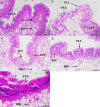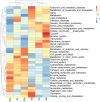Responses of survival, antioxidant system and intestinal microbiota of native snail Bellamya purificata to the invasive snail Pomacea canaliculata
- PMID: 39261504
- PMCID: PMC11391085
- DOI: 10.1038/s41598-024-71520-1
Responses of survival, antioxidant system and intestinal microbiota of native snail Bellamya purificata to the invasive snail Pomacea canaliculata
Abstract
Pomacea canaliculata is one of the most successful invader in worldwide, adversely affecting native ecosystem through direct predation or indirect competition, while the mechanism of indirect effects on native species remain poorly understood. To clarify the effects of P. canaliculata on the native near-niche species, Bellamya purificata, a widespread freshwater gastropod in China, was selected as the research subject. The changes of mortality, histology, antioxidant system as well as the intestinal flora diversity of B. purificata were explored in present study. The results showed that the median lethal dose of P. canaliculata culture solution for B. purificata was 23.76 ind/L and a concentration-dependent damage of both the gonad and hepatopancreas were observed, the gonadal villi were dissolved and the hepatopancreas cells were broken at 20 ind/L. Furthermore, different concentrations of P. canaliculata culture solution leading to the antioxidant damage on the enzyme or non-enzyme systems of B. purificata at various degrees. Additionally, a decrease in the diversity of the intestinal flora was observed, accompanied by an increase in the abundance of pathogenic bacteria such as Pseudomonas and Aeromonas after the exposure of the culture solution of P. canaliculata. Last, after being recovered in freshwater for 24 h, the antioxidant damage of B. purificata and the disturbance of intestinal flora diversity were still not recovered especially in the high concentration group. The indirect competitive mechanism of P. canaliculata culture solution on B. purificata were explored from the aspects of tissue, biochemical level and intestinal flora, which enriched the research of P. canaliculata invasion on native snails in China, and provided new insights for the study of the invasion strategy of P. canaliculata.
Keywords: Pomacea canaliculata; Antioxidant system; Histological damage; Intestinal microbiota; Invasion mechanism.
© 2024. The Author(s).
Conflict of interest statement
All authors declare that we have no financial and personal relationships with other people or organizations that can inappropriately influence our work, there is no professional or other personal interest of any nature or kind in any product, service and/or company that could be construed as influencing the position presented in, or the review of, the manuscript entitled, “Responses of survival, antioxidant system and intestinal microbiota of native snail
Figures






References
-
- MEA. Millenium Ecosystem Assessment: Ecosystems and Human Well-Being—Synthesis (2005).
-
- Pimentel, D., Zuniga, R. & Morrison, D. Update on the environmental and economic costs associated with alien-invasive species in the United States. Ecol. Econ.52, 273–288. 10.1016/j.ecolecon.2004.10.002 (2005). 10.1016/j.ecolecon.2004.10.002 - DOI
-
- Xu, H. et al. The distribution and economic losses of alien species invasion to China. Biol. Invasions8, 1495–1500. 10.1007/s10530-005-5841-2 (2006). 10.1007/s10530-005-5841-2 - DOI
MeSH terms
Substances
Grants and funding
- CARS-49/Modern Agro-industry Technology Research System
- 2019RD12/Innovation Support Program for High-level Talents of Dalian City
- 201818/the Overseas Training Program for Innovation Team of Liaoning Province
- 2020RQ109/Innovation and Entrepreneurship Project for High-Level Talents of Dalian
- LJKMZ20221107/Basic scientific research project of Education Department of Liaoning province
LinkOut - more resources
Full Text Sources
Medical
Research Materials

